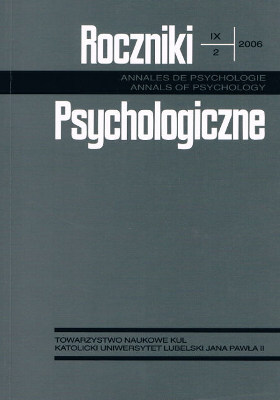Skala skuteczności przedsiębiorczej SSP
Abstrakt
Przekonanie o własnej skuteczności może odnosić się do różnych obszarów funkcjonowania, różnych zadań. Artykuł prezentuje skalę do pomiaru przekonania o skuteczności w podejmowaniu działań związanych z zakładaniem własnej firmy. Została ona opracowana na podstawie dwukrotnego badania grupy 315 potencjalnych przedsiębiorców. Wyniki analizy czynnikowej pozwoliły na wyodrębnienie trzech węższych obszarów skuteczności przedsiębiorczej: przekonania o skuteczności w zbieraniu informacji rynkowych, w podejmowaniu aktywności przedsiębiorczej oraz przekonania o skuteczności finansowo-prawnej. Metoda uzyskała wysoki wskaźnik zgodności wewnętrznej – α Cronbacha 0,96. Jej pozytywne korelacje z dotychczasowym doświadczeniem, a także z wynikami Skali Uogólnionej Własnej Skuteczności GSES, Skali Samooceny SES, Testu Orientacji Życiowej LOT-R, Kwestionariusza Nadziei na Sukces KNS oraz istotnie wyższe wyniki u osób, które zamierzają założyć własną firmę, pozwalają uznać ją za trafne narzędzie oceny przekonania o skuteczności przedsiębiorczej.
Bibliografia
Bandura, A. (1986). Social foundations of thought and action: A social cognitive theory. Englewood Cliffs, NY: Prentice Hall.
Bandura, A. (1997). Self-efficacy. The exercise of control. New York: Freeman & Co.
Bandura, A. (2000). Cultivate self-efficacy for personal and organizational effectiveness. W: E. A. Locke (red.), Handbook of principles of organization behavior (s. 120-136). Oxford, UK: Blackwell.
Bandura, A. (2001). Social cognitive theory: An agentic perspective. Annual Review of Psychology, 52, 1-26.
Bandura, A., Locke, E. A. (2003). Negative self-efficacy and goal effects revisited. Journal of Applied Psychology, 88, 1, 87-99.
Chen, Ch. C., Greene, P. G., Crick, A. (1998). Does entrepreneurial self-efficacy distinguish entrepreneurs from managers? Journal of Business Venturing, 13, 295-316.
Dzwonkowska, I., Łaguna, M., Lachowicz-Tabaczek, K. (2006). Skala Samooceny SES M. Rosenberga (materiały nieopublikowane).
Gatewood, E. J., Shaver, K. G., Gartner, W. (1995). A longitudinal study of cognitive factors influencing start-up behaviors and success at venture creation. Journal of Business Venturing, 10, 371-391.
Gist, M. E. (1987). Self-efficacy: Implications for organizational behavior and human resource management. Academy of Management Journal, 12, 472-485.
Hornowska, E., Paluchowski, W. J. (2004). Kulturowa adaptacja testów psychologicznych. W: J. Brzeziński (red.), Metodologia badań psychologicznych. Wybór tekstów (s. 151-191). Warszawa: PWN.
Jerusalem, M., Schwarzer, R. (1992). Self-efficacy as a resource factor in stress appraisal processes. W: R. Schwarzer (red.), Self-efficacy. Thought control of action (s. 195-213). Washington: Hemisphere Publishing Corp.
Juczyński, Z. (2001). Narzędzia pomiaru w promocji i psychologii zdrowia. Warszawa: Pracownia Testów Psychologicznych PTP.
Krueger, N. F. Jr (2000). The cognitive infrastructure of opportunity emergence. Entrepreneurship: Theory and Practice, 24, 3, 5-23.
Krueger, N., Dickson, P. (1994). How believing in ourselves increases risk taking: Self-efficacy and perceptions of opportunity and threat. Decision Science, 25, 385-400.
Krueger, N. F., Reilly, A. L., Carsrud, A. L. (2000). Competing models of entrepreneurial intentions. Journal of Business Venturing, 15, 411-432.
Łaguna, M., Trzebiński, J., Zięba, M. (2005). Kwestionariusz Nadziei na Sukces. Warszawa: Pracownia Testów Psychologicznych PTP.
Markman, G. D., Balkin, D. B., Baron, R. A. (2002). Inventors and new venture formation: The effects of general self-efficacy and regretful thinking. Entrepreneur Theory and Practice, 4, 149-165.
Markman, G. D., Baron, R. A. (2003). Person-entrepreneurship fit: Why some people are more successful as entrepreneurs than others. Human Resource Management Review, 13, 281-301.
Markman, G. D., Baron, R. A., Balkin, D. B. (2005). Are perseverance and self-efficacy costless? Assessing entrepreneurs’ regretful thinking. Journal of Organization Behavior, 26, 1, 1-19.
Oettingen, G., Mayer, D. (2002). The motivating function of thinking about the future: Expectations versus fantasies. Journal of Personality and Social Psychology, 83, 1198-1221.
Oleś, P. K. (2003). Wprowadzenie do psychologii osobowości. Warszawa: Scholar.
Pajares, F. (2002). Overview of social cognitive theory and of self-efficacy; http://www.emory.edu/ EDUCATION/mfp/eff.html, 11.03.2003.
Pajares, F., Hartley, J., Valiante, G. (2001). Response format in writing self-efficacy assessment: Greater discrimination increases prediction. Measurement and Evaluation in Counseling and Development, 33, 214-221.
Paulhus, D. (1983). Sphere-specific measure of perceived control. Journal of Personality and Social Psychology, 44, 1253-1265.
Paulhus, D. L. (1990). The Spheres of Control Scale: 10 yrs of research. Personality and Individual Differences, 11, 10, 1029-1036.
Pervin, L. A. (2002). Psychologia osobowości. Gdańsk: GWP.
Pervin, L. A., John, O. P. (2002). Osobowość: teoria i badania. Kraków: Wyd. UJ.
Rosenberg, M. (1989). Society and adolescent self-image. Revised edition. Middletown, CT: Wesleyan University Press.
Scheier, M. F., Carver, Ch. S. (1985). Optimism, coping, and health: Generalized outcome expectancies. Health Psychology, 4, 3, 219-247.
Scheier, M. F., Carver, Ch. S., Bridges, M. W. (1994). Distinguishing optimism from neuroticism (and trait anxiety, self-mastery, and self-esteem): A reevaluation of the Life Orientation Test. Journal of Personality and Social Psychology, 67, 6, 1063-1078.
Shane, S., Locke, E. A., Collins, Ch. J. (2003). Entrepreneurial motivation. Human Resource Management Review, 13, 257-279.
Shapero, A. (1982). Social dimensions of entrepreneurship. W: C. A. Kent, D. L. Sexton, K. H. Vesper (red.), The encyclopedia of entrepreneurship (s. 72-90). Englewood Clifs, NJ: Prentice-Hall.
Shook, Ch. L., Priem, R. L., McGee, J. E. (2003). Venture creation and the entreprising individual: A review and synthesis. Journal of Management, 29, 3, 379-399.
Skaalvik, E. M., Skaalvik, S. (2004). Self-concept and self-efficacy: A test of the internal/external frame of reference model and predictions of subsequent motivation and achievement. Psychological Reports, Part 2, 95, 3, 1187-1203.
Snyder, C. R. (2002). Hope theory: Rainbows in the mind. Psychological Inquiry, 13, 4, 249-275.
Stajkovic, A. D., Luthans, F. (1998). Self-efficacy and work-related performance: A meta-analysis. Psychological Bulletin, 124, 2, 240-261.
Vecchio, R. P. (2003). Entrepreneurship and leadership: Common trends and common threads. Human Resource Management Review, 13, 303-327.
Wood, R., Bandura, A. (1989). Social cognitive theory of organizational management. Academy of Management Review, 14, 3, 361-384.
Zakrzewski, J. (1987). Poczucie skuteczności a samoregulacja zachowania. Przegląd Psychologiczny, 30, 3, 661-677.
Copyright (c) 2006 Roczniki Psychologiczne

Utwór dostępny jest na licencji Creative Commons Uznanie autorstwa – Użycie niekomercyjne – Bez utworów zależnych 4.0 Międzynarodowe.


